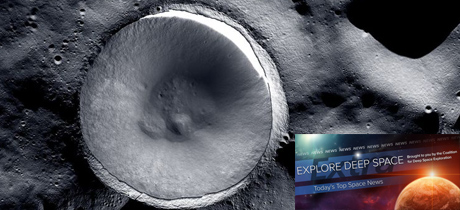Subscribe to our Daily Newsletter:
Don’t miss the latest developments in space policy, science, and exploration with Deep Space Extra, delivered directly to your inbox from Monday to Friday.
|
|
Here is a list of news that were published in our Newsletter the week of September 10, 2023:
Human Space Exploration:
- FAA seeks to wrap up Starship safety review in October
- Incredible new moon images show Artemis III landing sites near the lunar south pole (photos)
- NASA astronaut looks forward to family hugs, peace and quiet after yearlong stay in space
- New drug shows potential to aid astronauts during future missions to moon and Mars
- NASA’s moonbound Artemis astronauts take new ride to launch pad in practice run
- Bang! Inflatable space station module blows apart in explosive test (video)
- Artemis II crew visits Bremen, as Germany signs the Artemis Accords
- The Artemis Accords: Changing the narrative from space race to space cooperation
- SpaceX Starship engine passes key test for Artemis III moon-landing mission (video)
- NASA hopes humanoid robots can help us explore the moon and Mars
- Artemis II and a new era of lunar science
- NASA astronaut Loral O’Hara and 2 cosmonauts launched to International Space Station
Space Science
- CME sparks strong geomagnetic storm
- NASA’s Ingenuity helicopter breaks altitude record on 59th Mars flight
- OSIRIS-REx asteroid probe makes final maneuver before Sept. 24 sample delivery
- How scientists are mitigating space travel’s risks to the human body
- Massive sun outburst smacks NASA spacecraft
- Here’s what the latest Mars rover has learned so far
- How asteroid Bennu caught NASA’s OSIRIS-REx spacecraft by surprise and nearly killed it along the way
- Japan’s SLIM moon lander completes 1st critical phase in Earth orbit
- FCC directing more satellite constellations to mitigate effects on astronomy
- We should be looking for small, hot Dyson Spheres
- NASA’s OSIRIS-REx spacecraft changed how we think about asteroids.
- We can’t see the first stars yet, but we can see their direct descendants
- Europa’s underground ocean seems to have the carbon necessary for life
- How NASA’s OSIRIS-REx will bring asteroid samples to Earth in 5 not-so-easy steps
- Independent reviewers find NASA Mars Sample Return plans are seriously flawed
- One CME just hit the Earth
- China builds new radio telescope to support lunar, deep-space missions
- If astronomers see these chemicals in a planet’s atmosphere, there’s likely an advanced civilization there
- NASA confirms summer 2023 was Earth’s hottest on record
Other News
- Radar-imaging satellite lost as Rocket Lab Electron rocket suffers launch failure
- China launches new batch of Yaogan reconnaissance satellites
- Stoke Space flies reusable upper stage prototype
- FAA proposes upper stage disposal rule to limit space debris
- Maxar Technologies reorganizes as two separate businesses
- Don’t panic if you see balloons hovering during America’s two upcoming solar eclipses
- China’s Galactic Energy suffers first launch failure
- Germany joins Artemis Accords
- Firefly launches Space Force ‘Victus Nox’ mission
Major Space Related Activities for the Week
- The October 1 start of the 2024 fiscal year continues to approach without an agreement among the U.S. House, Senate and White House on an appropriated budget. Failure to reach agreement could call on the parties to sign a Continuing Resolution (CR) to operate federal agencies at 2023 appropriations levels to avoid a shutdown of the federal government with some exceptions.
- NASA astronaut Frank Rubio is on course to set a 371-day record for the longest space flight by an American upon his planned September 27 return to Earth from the International Space Station (ISS). He will host a NASA news briefing on Tuesday at 12:15 p.m. EDT, which will air on NASA TV and stream over www.nasa.gov/nasalive.
- NASA’s Lunar Exploration Analysis Group meets in person and virtually on Wednesday through Friday. A major event is to unfold next Sunday as NASA’s OSIRIS-REx mission spacecraft drops off samples from the asteroid Bennu for a parachute assisted descent into the Utah desert. The sample canister that will be recovered and flown the following day to NASA’s Johnson Space Center (JSC) may hold new information on how the planets formed and like the Earth came to possess water and the organic chemistry that provided the building blocks for life. NASA plans to provide live coverage of the recovery activities from Utah over NASA TV and www.nasa.gov/nasalive beginning at 10 a.m. EDT. OSIRIS-REx launched in September of 2016, arrived at Bennu in December 2018, touched down briefly on Bennu in October 2020 and began its journey back to Earth in May 2021.

